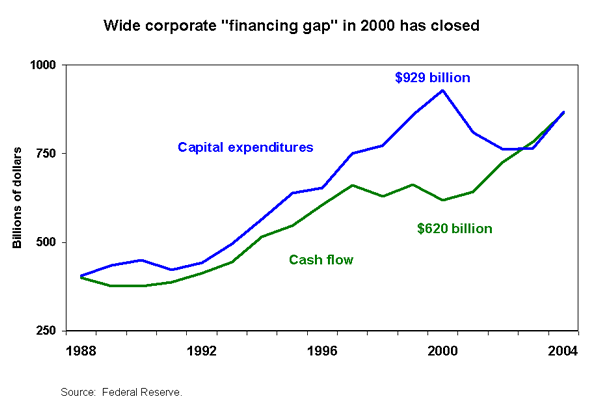See Snapshots Archive.
Snapshot for September 29, 2004.
Decline in corporate borrowing helps keep interest rates low
The dramatic withdrawal of corporations from the capital markets over the last four years helps to explain why interest rates have remained low. In normal times, corporations have greater capital expenditures than their internal cash flow can cover. This creates a so-called “financing gap” that they fill by borrowing money and issuing stock. Corporations had an unusually large financing gap of $309 billion in 2000 that swung around to a rare negative gap in 2003, and a negligible $2 billion gap in the first half of this year.
In 2000, corporations had $929 billion in capital expenditures, almost 50% larger than their $620 billion cash flow. As shown in the figure below, capital expenditures plunged between 2000 and 2002, then hit a plateau in 2003, and have rebounded somewhat in the last year. Meanwhile, corporate cash flow has surged every year since 2001. Rising cash flow has made it possible for corporations to finance almost all of the growth in capital expenditures in the last year without borrowing.

Just the opposite is true for the federal government. The federal government’s surpluses effectively contributed $236 billion to the capital markets in fiscal year 2000. This year the government must borrow to finance a projected $422 billion deficit. That’s a swing of $658 billion in just four years. But because corporations have generally not needed to borrow (and the United States has borrowed more from abroad), there has been no “crowding” of the capital markets. If capital expenditures continue to grow but cash flow slows down, as many forecasters predict, that will create substantial corporate borrowing—and higher interest rates—in the future.
This week’s Snapshot was written by EPI Research Director Lee Price.
